Last year was the slowest year for new condominium sales in Toronto since 1996
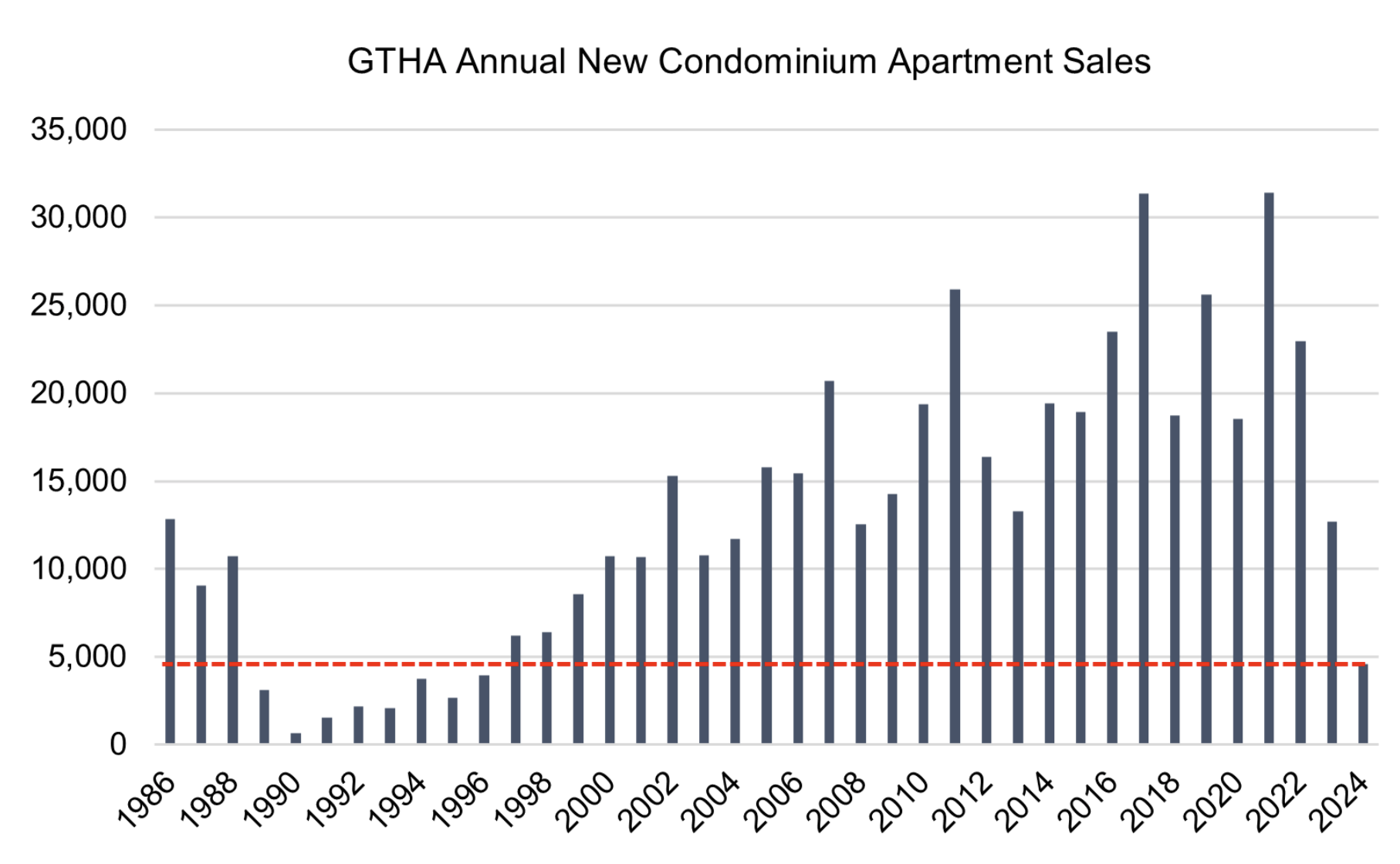
Here's some unsurprising but important news via Urbanation:
New condominium apartment sales last year totalled 4,590 homes. This is a 78% decline compared to the latest 10-year average of 20,835 homes, and the slowest year for new condo sales in the Greater Toronto and Hamilton Area (GHTA) since 1996. See above chart.
Only 802 new condominium apartments were sold in Q4-2024.
Six projects launched in Q4-2024, totalling 1,829 homes, of which only 10% were sold. A total of 1,506 new condominium apartments started construction during this same quarter.
A total of 29,800 condominium homes were completed in 2024 -- a record. This year, 30,793 homes are expected to complete, which if it happens, will create another new record.
In total, 78,742 new condominium homes are currently under construction across the GTHA, as of Q4-2024.
This may seem like a lot. But 30k of these homes are expected to complete and occupy this year. That leaves around 48k under construction, plus whatever new starts end up happening in 2025. So as Shaun Hildebrand points out in the above release, at some point around 2026-2027, we are going to see a dramatic fall off in completions and new housing supply.
Even if starts magically ramped up this year (which would be unexpected), there would still be a period of relatively low completions that would need to work its way through the system. Development is, by nature, excruciatingly slow to respond to changes in demand. There's always a lag. So overall housing supply is something we're paying close attention to right now as we execute on our real estate strategies.
Chart via Urbanation
Mapping rail transit access for 250 cities around the world
The key to making transit useful for people is not very complicated. It is highly dependent on population densities. In other words, it works best when it's proximate to as many people as possible. And so the more low density a city is, the harder it is for this to be true. It just isn't feasible to run that many lines. To that end, here's an interesting study by the School of Cities at the University of Toronto that compares rail transit and population density for 250 cities around the world.
This is what Toronto vs. Hong Kong looks like:
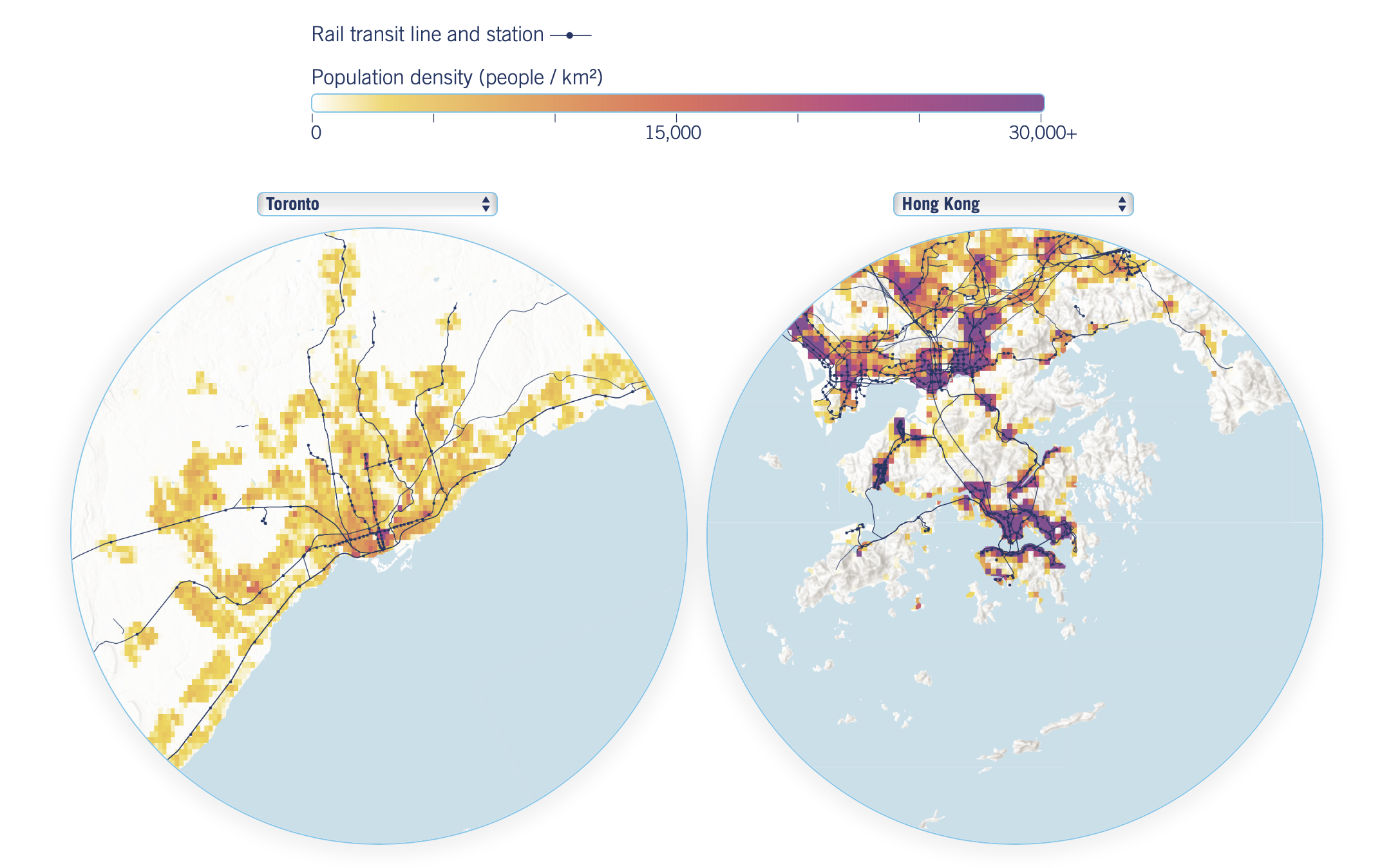
I chose Hong Kong because, according to this dataset, it has the highest percentage of people living within 1 km of a major rail transit station at 75.8%. Toronto, on the other hand, sits at 20%, which is frankly not very good (though I don't see our slow-moving streetcars on the above map). It's also why our bus network has to do so much heavy lifting to get people to rail. This places us 8th in the US and Canada (see below). Once again, when it comes to transit in this part of the world, there's New York, and then everyone else:
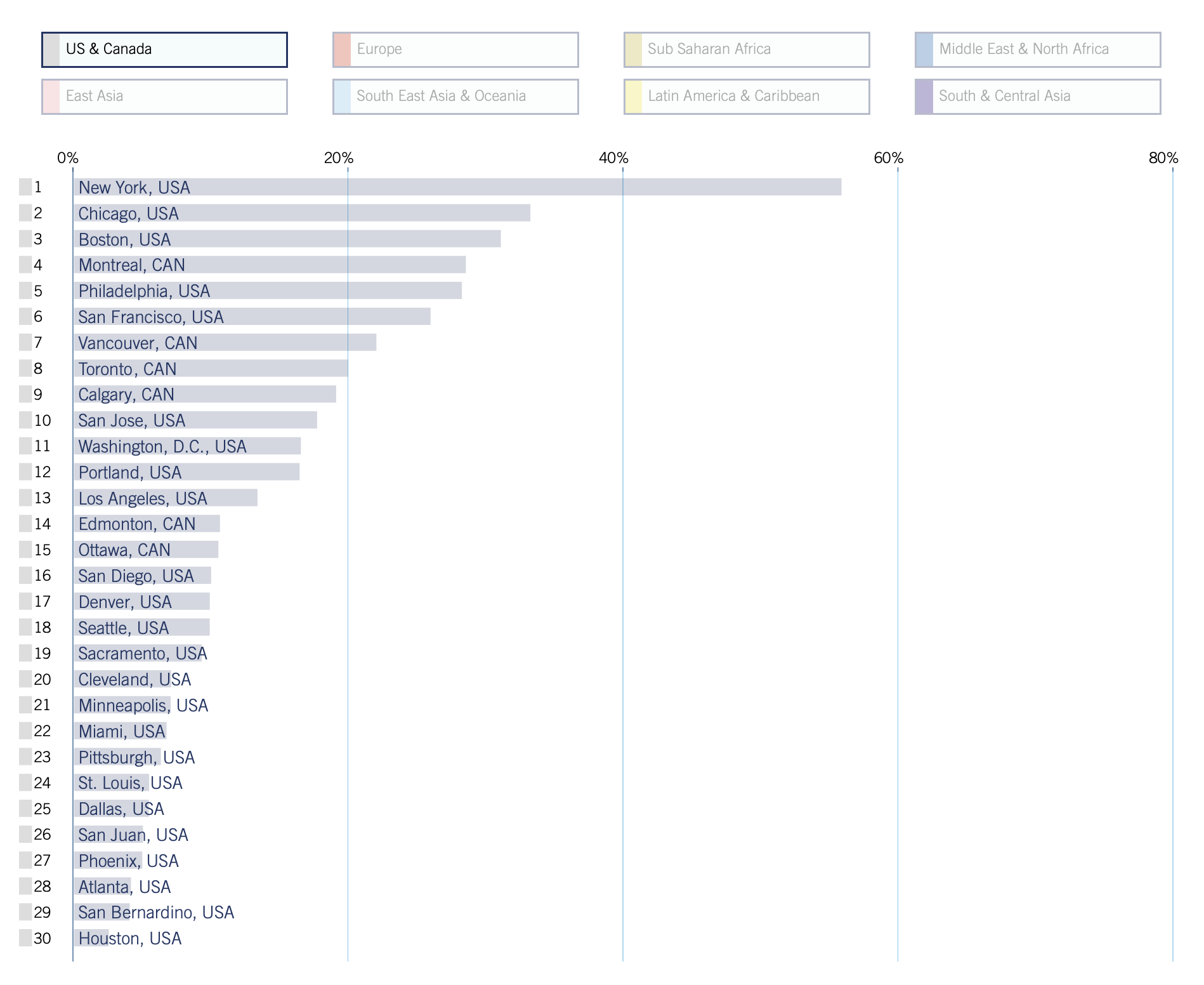
But add in the rest of the world -- most notably Europe and East Asia -- and New York drops down to 17th position:

This, to me, is a critically important metric. For what share of residents is rail transit close and convenient? In cities like Hong Kong, Paris, and Stockholm, it is the majority of the urban population. But for the majority of cities in Canada and the US, the answer is a very small percentage. To improve this, you can obviously build more lines. And that's certainly part of it. But to really maximize the value of these investments, you also need density. I hope our city leaders are paying attention to this metric.
Spain proposes 100% tax on property purchases by non-EU buyers
Spain is a beautiful country and lots of people want to visit and/or buy property there. But here's what Prime Minister Pedro Sánchez recently had to say about this:
Just to give an idea, in 2023 alone non-European Union residents bought around 27,000 houses and flats in Spain. And they didn't do it to live in them, they didn't do it for their families to have a place to live, they did it to speculate, to make money from them, which we – in the context of shortage that we are in – obviously cannot allow.
And by cannot allow, he means that Spain is preparing to implement a 100% tax on property purchases made by buyers of non-EU countries, such as the UK. It's not quite a foreign buyer ban, but it's certainly a punitive tax that should, in theory, dissuade the majority of buyers.
I am, however, unclear as to how this will interact with Spain's golden visa program. For over 10 years, Spain has been encouraging foreigners to buy real estate in the country (minimum value of €500,000) in exchange for permanent residency.
Will this program remain, and will these foreign buyers now be taxed at 100%? Or will permanent residency also exempt you? I don't know.
Whatever the case, it is yet another example of government trying to appear as if they're doing something meaningful about housing affordability. You might also remember that, last year, Barcelona came out with a complete ban of short-term rentals starting in November 2028.
But once again, I think it's important to remember that economics is the study of choice and that there are always tradeoffs. A decision in one place, will create second-order consequences somewhere else.
Nobody looks above the third floor
One of the many arguments that Brian Potter makes in this recent article called "Why Skyscrapers Became Glass Boxes" is that most people don't really care about the exterior of buildings. Hence one of the reasons why the market moved toward ever-greater architectural simplicity.
He quotes the late Chicago-based developer James Loewenberg:
“The person who looks to buy or rent a unit in a high-rise,” says Loewenberg, “only cares about three things: the location of the building, the layout of their unit, and the view from their unit. They don’t care as much about the physical appearance of the building and it is my contention that they never really look above the third floor…”
But I don't think this is exactly true. Also, Loewenberg was the founder of Magellan Development, which is responsible for developing two Studio Gang-designed towers: the Aqua Tower and the Vista Tower (now the St. Regis Chicago). Both of these buildings are designed for people who might look above the third floor.
For more on this topic, here and here are two related posts.
What robotaxis are doing to our cities
Bloomberg recently interviewed the outgoing head of San Francisco's transportation agency -- Jeffrey Tumlin -- about the impact that self-driving cars have had on the city. Along with maybe Phoenix, San Francisco has the most direct experience. Robotaxis have already been operating in the city for four years.
It's an interesting interview. On the one hand, robotaxis have, according to Tumlin, gotten better than most humans at "seeing" and predicting the behaviours of pedestrians. They offer slow and steady law-abiding rides, which is arguably not how must humans drive. This is a safety improvement.
But on the other hand, robotaxis still represent a fundamentally inefficient use of roadway space. They take up just as much space as human-operated cars, but importantly, they offer a less frustrating driving experience. Meaning they tend to induce demand, much like ride-hailing platforms.
In a 2018 study by San Francisco County, they found that roughly 50% of the increase in vehicle miles traveled in the region was due to Uber and Lyft. So not surprisingly, there are important things that will need to be figured out as robotaxis continue to spread across our cities.
I also find the comparison in the interview between San Francisco and Phoenix to be particularly interesting. The former is walkable. The latter is not. And this seems to be creating a different experience with self-driving cars because robo or not, in Phoenix, traveling by car is pretty much the only option.
For the full interview, click here.
Importantly, Toronto proposes new Avenues
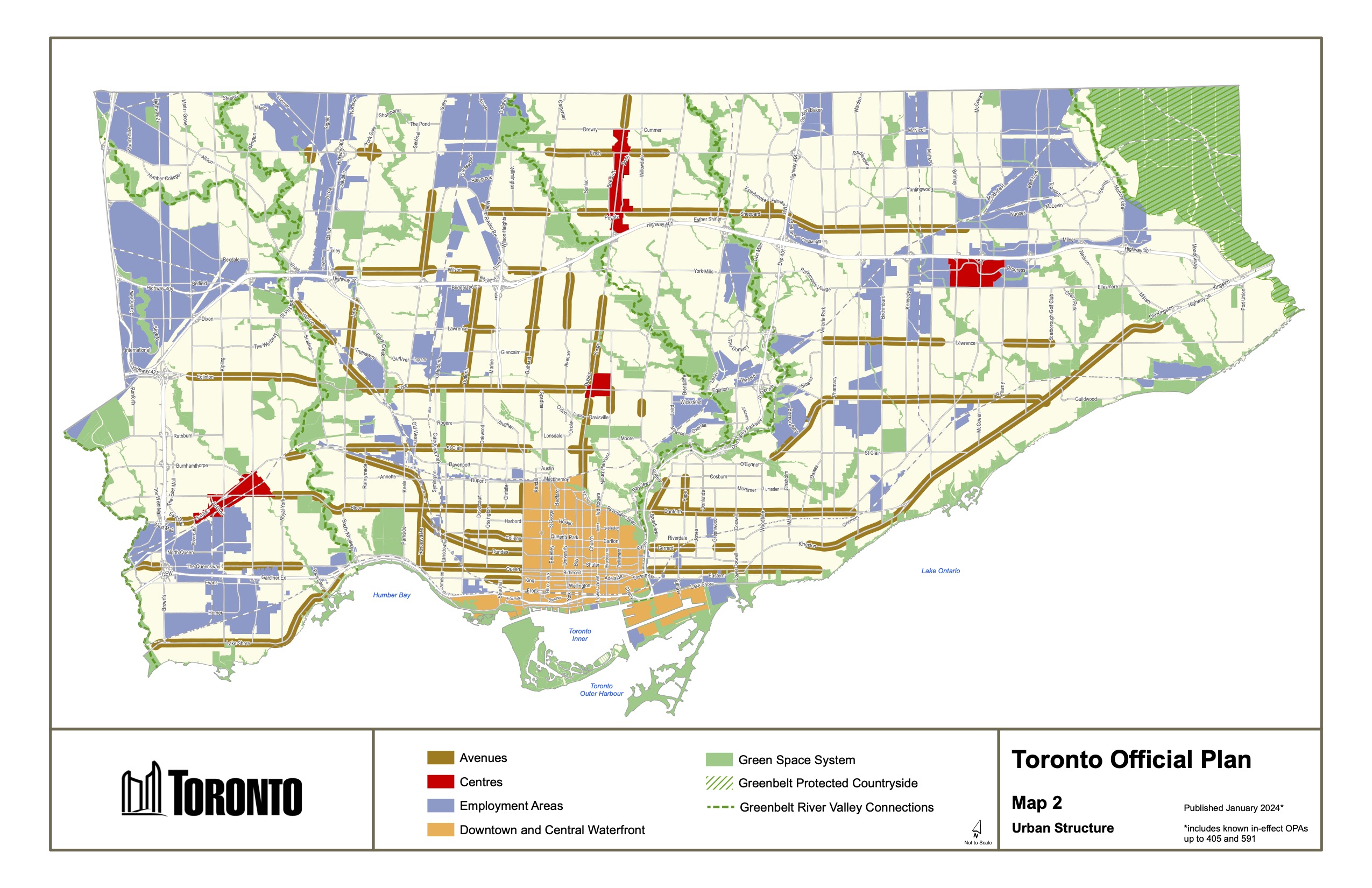
This is Map 2 from Toronto's Official Plan, dated January 2024. It shows the city's "urban structure", and one of the main things it tells us is where the city is anticipating growth. You have the downtown and central waterfront, urban "Centres", and then "Avenues." All three of these colored areas are where growth and intensification are encouraged. The problem, however, is that it still resembles a mono-centric city, with a dominant core and then mostly low-rise housing surrounding it. The Centres in the inner suburbs are relatively small and many of the Avenues are broken up without a lot of connectivity back to the rest of the city's grid. It sets us up for a divided city -- core versus the rest -- because different built forms naturally create different political priorities.
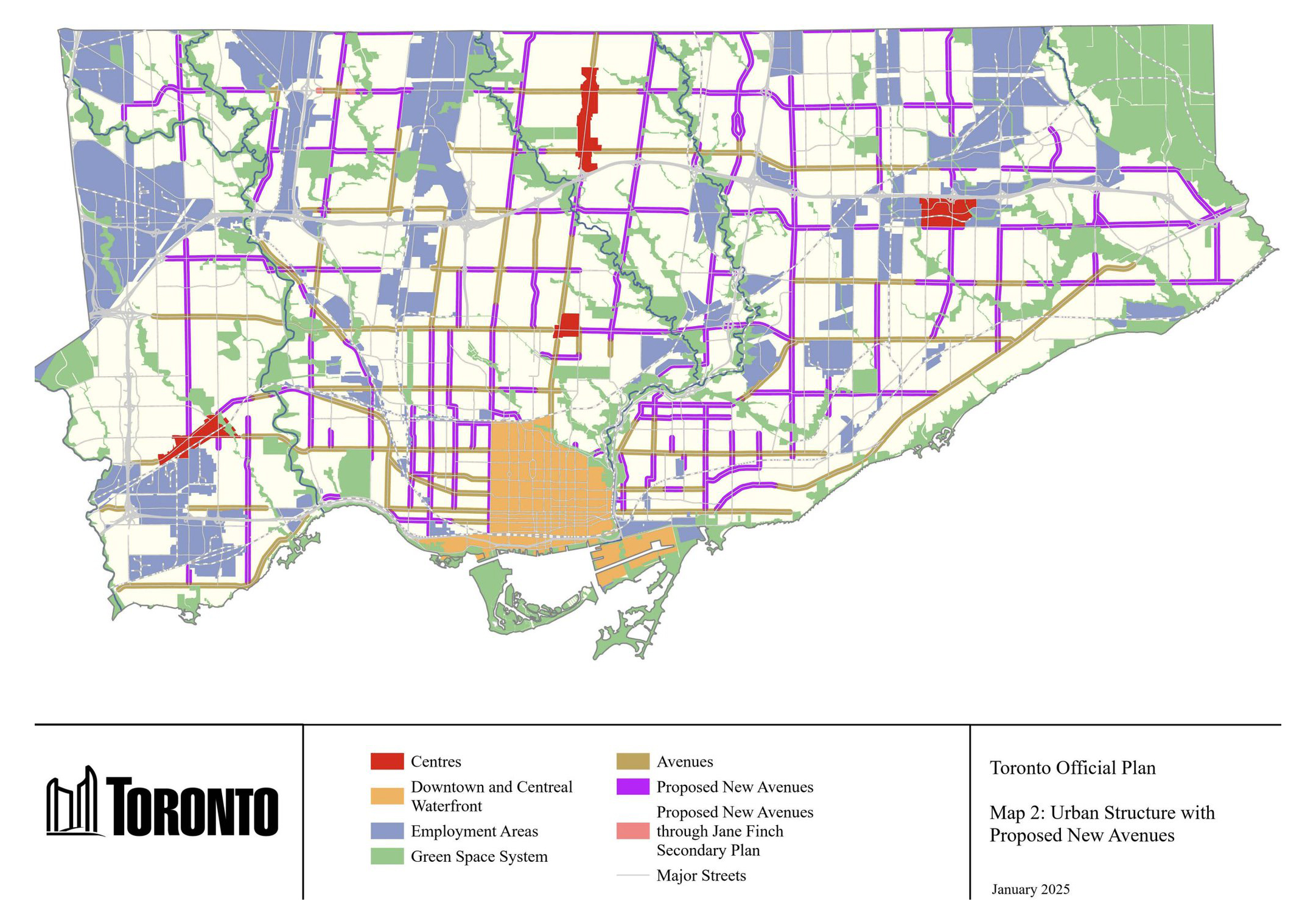
Now let's look at what Toronto has just proposed in terms of new Avenues (shown above in purple). This is the kind of thing that immediately gets me excited because, as proposed, it implies a significant upzoning for a large portion of the city and it creates a much more uniform urban structure. Here, we have a blanket of intersecting Avenues, which will open up a ton of new housing opportunities and make it far more feasible to build efficient transit and other mobility solutions across the city. In fact, I'd argue that this is one of the most important land use discussions taking place in Toronto today. It's foundational to moving us away from the anachronistic model of the car-oriented North American city.
Now we just need to make it happen, and then empower developers and builders of all scales to build housing and a mix of uses all along these purple lines. For more on this, check out the City of Toronto's Housing Action Plan.
Cover photo by Adam Vradenburg on Unsplash
Tall and skinny in Ho Chi Minh City
Also on Conde Nast Traveler's list of the best places to go this year is Ho Chi Minh City. I've never been, but I would love to go. More importantly, though, check out the photo they used, which is of the city's first Michelin-starred restaurant, Anan Saigon:

From what I can tell, the building (and lot) is maybe 3-4m wide. And it looks to be 7 storeys (the top floor is partially concealed because of the angle of the camera).
On the first two floors you have what I am presuming to be the main restaurant spaces. On the third floor there is a bar. Maybe this is also part of the restaurant. And on the fourth floor you have Anan's pho restaurant (I checked their website).
Above that it looks to flip to residential. And then again above that it looks to be residential. Finally, on the top floor it appears to be more commercial in nature, so I'm guessing it's a rooftop bar for Anan. If anyone has been here, please let me know if I'm getting this right.
Regardless, this is a terrific photo and a powerful example of what's possible on small urban lots if you just let people build.
A great hotel can help you build your city
Hotels are an important city-building tool. Let me give you an example. Each year, Conde Nast Traveler publishes a list of the best places to visit right now. Here's the 2025 list. If you scroll through it, one of the 25 places you'll find is Marseille. And if you look at the first picture, you'll find a hotel/restaurant called Tuba Club.
Long-time readers of this blog will know that I'm a big fan of Marseille and that, back in 2021, Neat B and I stayed at this hotel. In fact, the whole reason we even decided to stop in the city for the first time was so that we could check out this exact place. It opened the summer before and I had seen it written up somewhere.
I can also tell you that if you flip through Monocle's new handbook about France and go to the hotel section, you will likewise find Tuba Club. The place is seemingly everywhere and now has a loyal following.
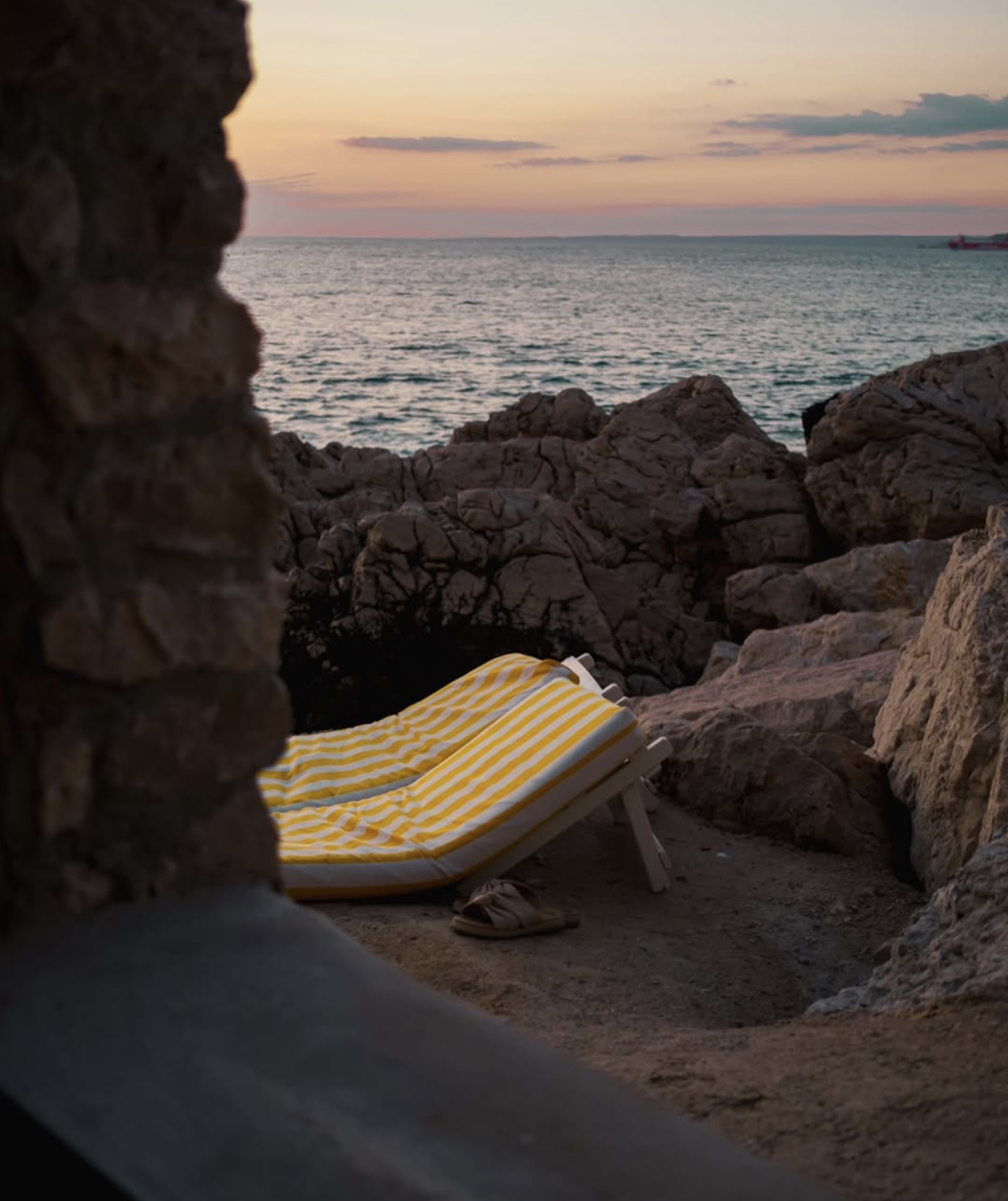
But here's the important thing: it only has 5 rooms! And the room we stayed in was best accessed via a window and a large rock outcropping beside it. There's no way this place would meet code anywhere in Canada. But boy was it cool. And because we loved the experience so much, we decided to go back to Marseille the following summer and check out more of the city. It didn't disappoint.
Now I tell people and write blog posts about how much I love Marseille. And it all started with 5 non-code-compliant rooms perched on a bunch of rocks in a sleepy fishing port on the south end of the city. A great hotel can help you build your city.
Data center energy usage as a share of the US total
Last month, the Berkeley National Laboratory, under contract with the US Department of Energy, published this report estimating total data center energy usage across the country. It also forecasted future demand out to 2028.
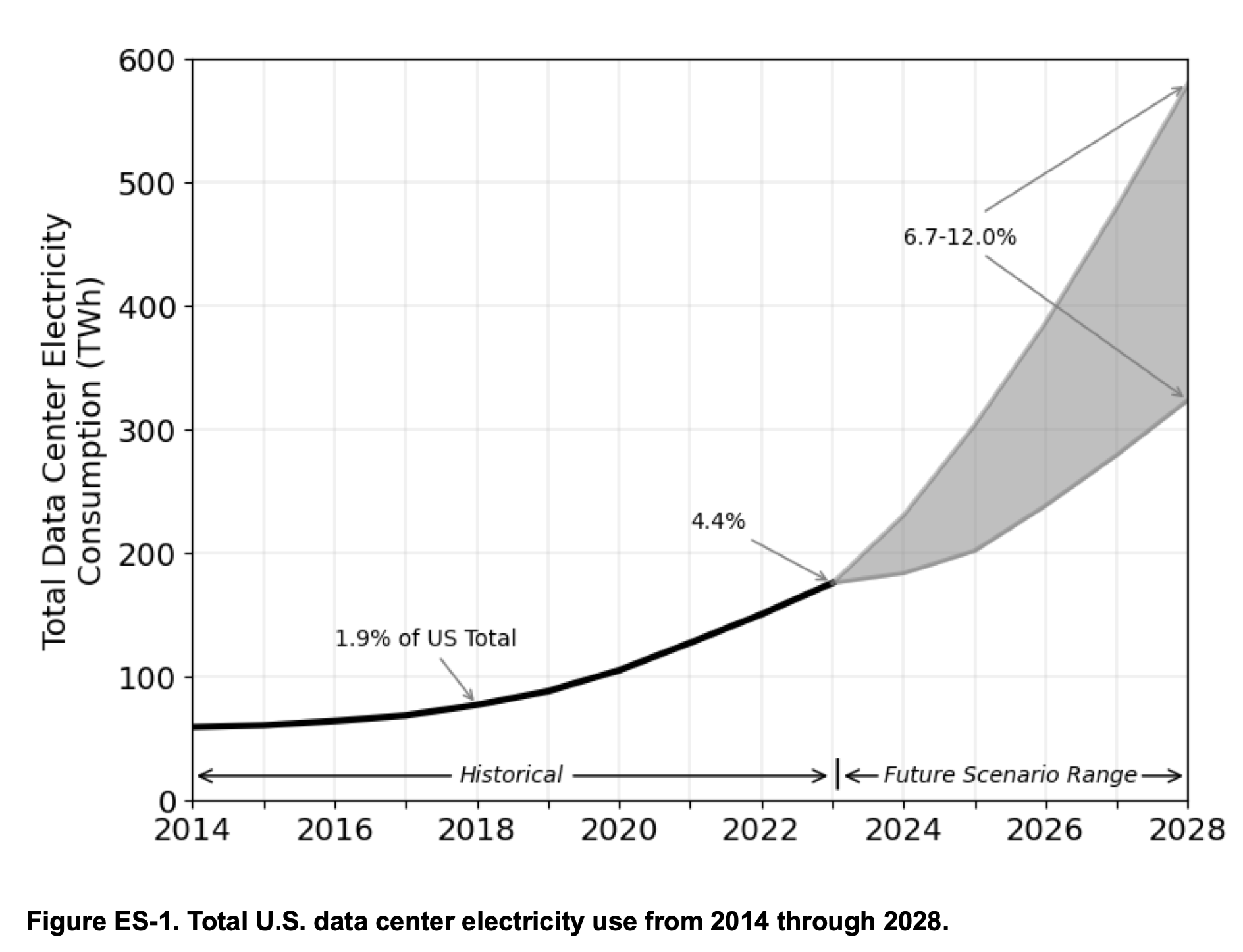
As you can see, in 2018, total electricity consumption by US data centers was estimated at approximately 76 TWh or 1.9% of the US total. In 2023, consumption more than doubled to 176 TWh or 4.4% of the US total. And by 2028, this is expected to further jump to somewhere between 6.7-12% of the US total.
Here's some commentary from the report:
With significant changes observed in the data center sector in recent years, owing to the rapid emergence of AI hardware, total data center energy use after 2023 is presented as a range to reflect various scenarios. These scenarios capture ranges of future equipment shipments and operational practices, as well as variations in cooling energy use. The equipment variations are based on the assumed number of GPUs shipped each year, which depends on the future GPU demand and the ability of manufacturers to meet those demands. Average operational practices for GPU-accelerated servers represent how much computational power, and how often AI hardware in the installed base is used, to meet AI workload demand. Cooling energy use variations are based on scenarios in cooling system selection type and efficiency of those cooling systems, such as shifting to liquid base cooling or moving away from evaporative cooling. Together, the scenario variations provide a range of total data center energy estimates, with the low and high end of roughly 325 and 580 TWh in 2028, as shown in Figure ES-1.
This strikes me as being an important macro trend and a big deal. All signs point to more data centers being needed. And before we know it, they're going to represent a meaningful chunk of total electricity usage.
Note: TWh = terawatt hour = one trillion watt hours
Not a hotel
I think that lots of people would like to live in multiple places around the world. I know I would. That's why when people get rich and have the means, they often start to buy second homes. To that end, here's an interesting concept out of Japan called Not a Hotel.
Their model is fairly simply. What they do is build incredible design-forward vacation homes across Japan and then sell fractional shares, while at the same time offering full concierge and management services.
The typical fraction is for 30 days (1/12th), but if you'd like, you can buy up to the entire year. Ownership gives you access to the property for the amount of days you've purchased, or you can trade your days and stay at other homes within the Not a Hotel network.
On the nights you don't use, the company operates the home like a hotel and the owner gets the benefit of reduced management fees.
Most of their homes are already completely sold out. But 1/12th of this home in Kitakaruizawa is available for US$490,000. And on the other end of the spectrum, 1/36th of this Bjarke Ingels-designed home is available for US$2,460,000.
Here's a video of the home:
Fractional ownership is not a new model, but it is still relatively niche. I also think that the way Not a Hotel is going about it -- with their focus on over-the-top design and architecture -- is pretty unique.
